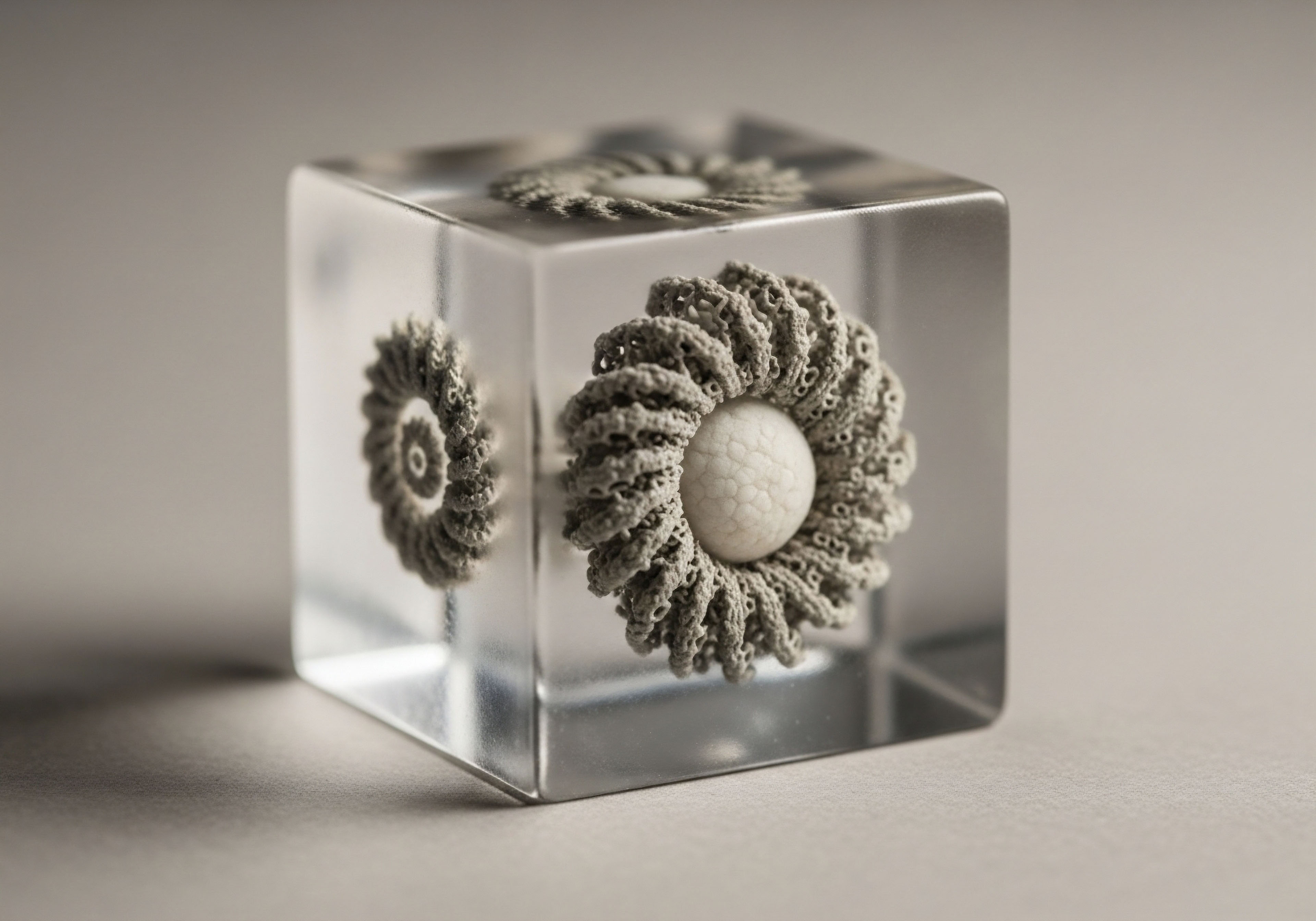

Fundamentals
When the familiar rhythm of your body begins to shift, perhaps with a subtle dip in energy, a quiet fading of desire, or a persistent mental fog, it can feel as though a vital part of yourself is receding. Many individuals experience these changes, often attributing them to the natural progression of life or the demands of daily existence.
Yet, these sensations frequently signal deeper alterations within the body’s intricate messaging system ∞ the endocrine network. Understanding these shifts, particularly concerning hormonal balance, marks the initial step toward reclaiming vitality and function.
The female endocrine system orchestrates a complex symphony of hormones, each playing a distinct role in overall well-being. While estrogen and progesterone are widely recognized for their influence on reproductive health and menopausal transitions, testosterone, often perceived as a primarily male hormone, holds significant importance for women too.
Produced in smaller quantities by the ovaries and adrenal glands, testosterone contributes to a spectrum of physiological processes, including the maintenance of sexual desire, bone density, muscle mass, cognitive sharpness, and emotional equilibrium.
As women progress through different life stages, particularly during perimenopause and postmenopause, the production of these essential biochemical messengers can decline. This gradual reduction, sometimes beginning as early as the late twenties, can lead to a constellation of symptoms that affect daily life and overall quality of life. Addressing these changes requires a precise and personalized approach, moving beyond a simplistic view of hormonal interventions.
Understanding the subtle shifts in your body’s hormonal landscape is the first step toward restoring your innate sense of well-being.

The Role of Hormones in Female Physiology
The interplay of estrogen, progesterone, and testosterone creates a delicate balance that supports numerous bodily functions. Estrogen, particularly estradiol, is central to reproductive health, bone maintenance, and cardiovascular integrity. Progesterone plays a role in menstrual cycle regulation, pregnancy support, and can exert calming effects on the nervous system. Testosterone, while present in lower concentrations than in men, acts directly on cells and also converts into estrogen, exerting vital biological effects through both androgen and estrogen receptors.
When this hormonal equilibrium is disturbed, symptoms can manifest across various systems. For instance, reduced testosterone levels can contribute to diminished libido, unexplained fatigue, changes in mood, and a decline in cognitive function. These experiences are not merely isolated occurrences; they are often interconnected signals from a system seeking recalibration. Recognizing these signals allows for a more targeted and effective strategy for restoring physiological harmony.


Intermediate
Navigating the landscape of hormonal interventions for female symptoms requires a clear understanding of specific clinical protocols and their underlying rationale. Low-dose testosterone therapy, while gaining recognition, exists within a broader spectrum of endocrine system support. Its application is distinct and often complementary to other hormonal strategies, particularly those involving estrogen and progesterone.

Comparing Hormonal Interventions
For many women experiencing symptoms related to hormonal changes, conventional hormone replacement therapy (HRT) primarily involves the administration of estrogen, often combined with progesterone if the uterus is still present. Estrogen therapy effectively addresses vasomotor symptoms like hot flashes and night sweats, and it supports vaginal health. Progesterone is included to safeguard the uterine lining from potential overgrowth caused by unopposed estrogen, thereby mitigating the risk of endometrial cancer.
Low-dose testosterone therapy, conversely, is typically considered when primary HRT with estrogen and progesterone alone does not adequately resolve specific symptoms, most notably persistent low sexual desire that causes personal distress. While estrogen alone can improve sexual function, the addition of testosterone has been shown to enhance desire, arousal, pleasure, and orgasm in postmenopausal individuals. This suggests a synergistic effect, where each hormone addresses distinct yet interconnected aspects of well-being.
Hormonal interventions are not interchangeable; each targets specific physiological pathways to restore balance.
The decision to incorporate testosterone therapy is highly individualized, reflecting a personalized wellness protocol. It is not a universal solution for all menopausal symptoms, but rather a targeted application for specific needs.

Clinical Protocols for Female Testosterone Optimization
When considering testosterone optimization for women, the aim is to restore physiological concentrations that align with those seen in healthy premenopausal women, avoiding supraphysiological levels that could lead to unwanted androgenic side effects. The typical protocol involves low-dose administration, often via subcutaneous injection or pellet therapy.

Testosterone Cypionate Administration
For subcutaneous injection, Testosterone Cypionate is commonly administered weekly, typically in very small doses ranging from 10 to 20 units (0.1 ∞ 0.2 ml). This method allows for consistent, controlled delivery, helping to maintain stable hormone levels. Regular monitoring of blood levels is essential to ensure the dosage remains within the therapeutic window and to prevent accumulation that could lead to adverse effects.

Pellet Therapy for Sustained Release
Pellet therapy offers a long-acting alternative, where small, custom-compounded testosterone pellets are inserted under the skin, usually in the hip or buttock area. These pellets slowly release testosterone over several months, providing sustained hormone levels without the need for frequent injections.
This method can be particularly appealing for individuals seeking convenience and consistent symptom management. When appropriate, Anastrozole may be co-prescribed with pellet therapy to manage any potential conversion of testosterone to estrogen, although this is less common in women due to the lower doses used compared to male therapy.
The choice between injections and pellets often depends on individual preference, lifestyle, and clinical assessment. Both methods prioritize maintaining physiological levels to optimize benefits while minimizing risks.

How Do Administration Methods Affect Outcomes?
The route of administration significantly influences how hormones are processed by the body and their systemic effects. Oral testosterone formulations, for instance, are generally not recommended for women due to their impact on liver metabolism and potential adverse effects on lipid profiles. Transdermal applications, such as gels or creams, and subcutaneous injections or pellets, bypass the initial liver pass, allowing for a more direct entry into the bloodstream and a more physiological hormone profile.
The following table summarizes key aspects of different hormonal interventions for female symptoms ∞
| Intervention Type | Primary Hormones | Common Administration | Main Symptom Targets | Considerations |
|---|---|---|---|---|
| Estrogen Therapy (ET) | Estrogen (Estradiol) | Oral tablets, transdermal patches, gels, sprays, vaginal rings/creams | Vasomotor symptoms (hot flashes, night sweats), vaginal atrophy, bone density support | Requires progesterone if uterus present; systemic vs. local effects vary |
| Combined Hormone Therapy (CHT) | Estrogen + Progestogen | Oral tablets, transdermal patches | Comprehensive menopausal symptom relief, uterine protection | Balances estrogen benefits with endometrial safety |
| Low-Dose Testosterone Therapy | Testosterone | Subcutaneous injections, pellets, topical creams/gels (off-label) | Low libido (HSDD), energy, mood, muscle strength, bone density | Often adjunctive to ET/CHT; not FDA-approved for women in US |
| Progesterone-Only Therapy | Progesterone | Oral tablets (micronized), IUD, vaginal gel | Endometrial protection, sleep support, mood modulation | Used with ET for uterine protection; can be used alone for specific indications |
Each intervention serves a distinct purpose within the broader framework of hormonal optimization. A comprehensive assessment of symptoms, individual health history, and laboratory values guides the selection of the most appropriate protocol.


Academic
A deeper understanding of low-dose testosterone therapy for female symptoms requires an exploration of its endocrinological underpinnings and its interaction within the complex systems of human physiology. This involves examining the intricate feedback loops that govern hormone production and the molecular mechanisms through which testosterone exerts its effects.

The Endocrine System’s Interconnectedness
The endocrine system operates as a sophisticated communication network, with various glands and hormones interacting through feedback loops. The Hypothalamic-Pituitary-Gonadal (HPG) axis serves as a central regulatory pathway for sex hormone production in both sexes. In women, the hypothalamus releases gonadotropin-releasing hormone (GnRH), which stimulates the pituitary gland to secrete luteinizing hormone (LH) and follicle-stimulating hormone (FSH). These gonadotropins, in turn, act on the ovaries to produce estrogen, progesterone, and androgens, including testosterone.
While the ovaries are the primary source of testosterone in premenopausal women, adrenal glands and peripheral conversion of other hormones, such as DHEA and androstenedione, also contribute to circulating testosterone levels. After menopause, the adrenal glands become a more significant source of androgens, though ovarian production continues to some extent. The decline in ovarian function with age leads to a gradual reduction in androgen production, contributing to symptoms often associated with hormonal aging.
The body’s hormonal systems are not isolated; they function as an integrated network, where changes in one hormone can influence many others.

Molecular Mechanisms of Testosterone Action in Female Tissues
Testosterone exerts its biological effects through two primary mechanisms ∞ direct binding to the androgen receptor (AR) and conversion to estradiol via the enzyme aromatase, followed by binding to estrogen receptors (ERs). In female tissues, both pathways are active, contributing to the diverse physiological roles of testosterone.
Androgen receptors are widely distributed throughout the female body, including in the brain, bone, muscle, adipose tissue, and clitoris. Activation of these receptors by testosterone influences various cellular processes, such as protein synthesis, cell growth, and gene expression. For instance, in skeletal muscle, testosterone’s interaction with ARs promotes muscle protein synthesis, contributing to muscle mass and strength. In bone, testosterone directly stimulates bone formation and inhibits bone resorption, thereby supporting bone mineral density.
The conversion of testosterone to estradiol, particularly in adipose tissue and the brain, means that some of testosterone’s beneficial effects, such as those on bone and cardiovascular health, may be mediated through estrogenic pathways. This dual mechanism of action underscores the complexity of testosterone’s role in female physiology and highlights why maintaining physiological levels is crucial.

Clinical Evidence and Safety Considerations
Clinical trials investigating low-dose testosterone therapy in women have primarily focused on its efficacy for hypoactive sexual desire disorder (HSDD) in postmenopausal women. A systematic review and meta-analysis of randomized controlled trials provided robust support for testosterone therapy in this specific indication, showing improvements in sexual desire, pleasure, arousal, and orgasm. However, the evidence for other indications, such as mood, cognition, and general well-being, remains less consistent across studies.
Long-term safety data for testosterone therapy in women are still limited, with most studies extending up to two years. Current data are reassuring regarding cardiovascular and breast outcomes when physiological doses are maintained. Adverse effects, when they occur, are typically dose-dependent and include androgenic manifestations such as acne, increased facial hair growth (hirsutism), and changes in body odor.
These are generally reversible upon dose reduction or discontinuation of therapy. Rare side effects like voice deepening or clitoral enlargement are associated with supraphysiological dosing and are largely avoidable with careful titration and monitoring.
Monitoring parameters for women receiving testosterone therapy typically include regular assessment of symptoms, physical examination for androgenic side effects, and periodic measurement of serum testosterone levels. The goal is to keep testosterone concentrations within the physiological range observed in healthy premenopausal women.

How Do Hormonal Interventions Influence Metabolic Pathways?
Hormones are profound regulators of metabolic function, and their balance significantly impacts glucose metabolism, lipid profiles, and body composition. Estrogen, for instance, generally has favorable effects on insulin sensitivity and lipid profiles, contributing to cardiovascular health. Testosterone also plays a role in female metabolic homeostasis.
Physiological levels of testosterone in women are associated with healthy body composition, including increased lean mass and decreased fat mass. Studies have shown that testosterone treatment, when maintaining concentrations within the female physiological range, can improve insulin sensitivity and reduce inflammation in androgen-deficient women.
However, supraphysiological levels of testosterone, such as those seen in conditions like polycystic ovary syndrome (PCOS), are linked to insulin resistance, visceral adiposity, and an increased risk of type 2 diabetes. This highlights the importance of precise dosing to achieve therapeutic benefits without inducing metabolic dysregulation.
The following table provides a summary of the metabolic considerations for various hormonal interventions ∞
| Hormone/Intervention | Impact on Insulin Sensitivity | Impact on Body Composition | Impact on Lipid Profile |
|---|---|---|---|
| Estrogen (Systemic) | Generally improved | Can influence fat distribution favorably | Improved HDL, reduced LDL (transdermal preferred) |
| Progesterone (Micronized) | Neutral to slightly improved | Generally neutral | Generally neutral |
| Testosterone (Physiological Dose) | Improved in androgen-deficient women | Increased lean mass, decreased fat mass | Generally neutral; oral forms can be adverse |
| Testosterone (Supraphysiological Dose) | Increased insulin resistance | Increased visceral adiposity | Adverse changes (e.g. lower HDL) |

What Are the Long-Term Implications of Hormonal Balance?
Maintaining optimal hormonal balance extends beyond immediate symptom relief; it holds implications for long-term health and disease prevention. Hormones influence cardiovascular health, bone integrity, cognitive function, and even immune system regulation. A balanced endocrine system supports the body’s resilience and adaptive capacity over time.
The careful titration of low-dose testosterone, alongside other hormonal interventions, aims to restore a physiological milieu that supports these broader health outcomes. This comprehensive approach recognizes that the body functions as an integrated system, where each component contributes to the overall state of well-being.

How Does Regulatory Status Influence Access to Therapy?
The regulatory status of testosterone for women varies significantly across regions. In many countries, including the United States, specific testosterone formulations are not officially approved for female use, leading to “off-label” prescribing under careful medical supervision. This regulatory landscape reflects the ongoing need for more extensive, long-term clinical trials specifically designed for women, as well as the development of pharmaceutical products tailored to female physiological dosing.
Despite the off-label status, clinical practice guidelines from various medical societies acknowledge the role of testosterone in treating specific conditions like HSDD in postmenopausal women, emphasizing the importance of individualized assessment and monitoring. This situation underscores a disconnect between clinical utility and formal regulatory approval, necessitating a collaborative approach between patients and knowledgeable healthcare providers.

References
- Dichtel, L. E. Carpenter, L. L. Nyer, M. et al. (2020). Low-Dose Testosterone Augmentation for Antidepressant-Resistant Major Depressive Disorder in Women ∞ An 8-Week Randomized Placebo-Controlled Study. American Journal of Psychiatry, 177(7), 613-623.
- Davis, S. R. & Wahlin-Jacobsen, S. (2015). Testosterone in women ∞ the clinical significance. The Lancet Diabetes & Endocrinology, 3(12), 980-992.
- Wierman, M. E. Arlt, W. Basson, R. et al. (2014). Androgen Therapy in Women ∞ A Reappraisal ∞ An Endocrine Society Clinical Practice Guideline. Journal of Clinical Endocrinology & Metabolism, 99(10), 3489-3510.
- Davis, S. R. Baber, R. & Panay, N. (2019). Global Consensus Position Statement on the Use of Testosterone Therapy for Women. Climacteric, 22(5), 425-434.
- Islam, R. M. Bell, R. J. Green, S. Page, M. J. & Davis, S. R. (2019). Safety and efficacy of testosterone for women ∞ a systematic review and meta-analysis of randomised controlled trial data. The Lancet Diabetes & Endocrinology, 7(11), 850-861.
- Watts, N. B. & Davis, S. R. (2015). Testosterone and women ∞ a review of current knowledge and clinical implications. The Journal of Clinical Endocrinology & Metabolism, 100(12), 4323-4330.
- Burger, H. G. (2002). Androgen production in women. Annals of the New York Academy of Sciences, 997(1), 29-37.
- Roney, J. R. & Simmons, Z. L. (2013). Increasing women’s sexual desire ∞ The comparative effectiveness of estrogens and androgens. Hormones and Behavior, 63(5), 742-753.
- Davis, S. R. & Wahlin-Jacobsen, S. (2015). Testosterone in women ∞ the clinical significance. The Lancet Diabetes & Endocrinology, 3(12), 980-992.
- Mauvais-Jarvis, F. & Davis, S. R. (2024). Metabolic benefits afforded by estradiol and testosterone in both sexes ∞ clinical considerations. Journal of Clinical Investigation, 134(17), e180073.

Reflection
Your personal health journey is a unique unfolding, a continuous dialogue between your body’s innate systems and the environment you inhabit. The insights shared here regarding hormonal health, particularly the role of low-dose testosterone therapy in the context of other interventions, are not merely clinical facts.
They represent guideposts on a path toward deeper self-understanding. Recognizing the subtle cues your body provides, and then seeking informed guidance, empowers you to make choices that align with your desire for vitality and sustained well-being. This knowledge serves as a foundation, inviting you to consider how these biological principles apply to your own lived experience, fostering a proactive stance in navigating your health.



